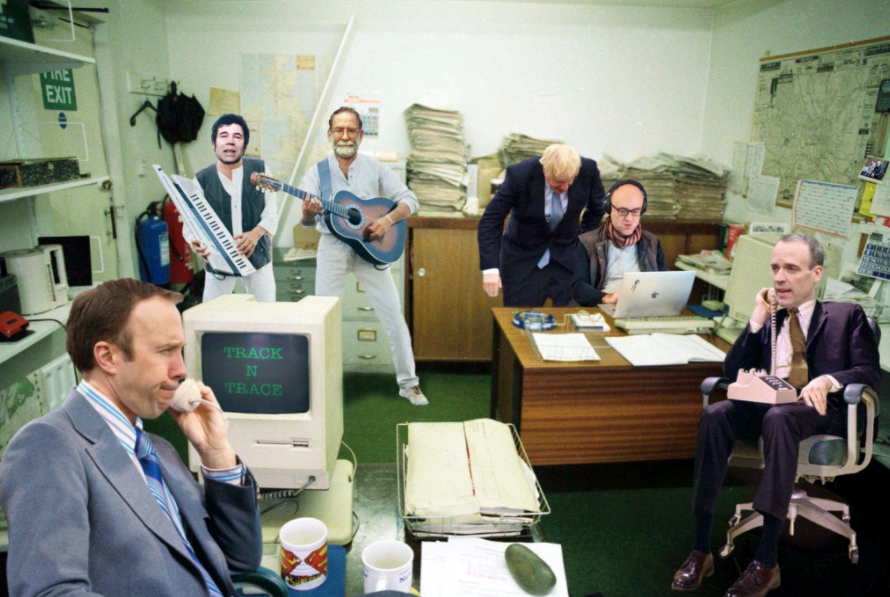Coronavirus has offered endless inspiration, but the effect on galleries has been catastrophic
I’m fortunate to be able to work as an artist during this troubling period in our history, but my industry will once again be tested by the new restrictions


If lockdown had occurred a year earlier, my life as an artist – save for the influence upon subject matter – wouldn’t have been impacted all that much. I’d be working from home in my role as a Probation Service Officer, while knocking out satirical photomontages during any spare time I could find. This year, however, it put paid to a nationwide exhibition I’d planned for April and the unveiling of a commission piece I’d completed for Birmingham Museum and Art Gallery.
The You, Me & Cold War Steve International Exhibition of the People was a do-it-yourself downloadable exhibition, with more than 100 confirmed locations participating, stretching from Falkirk to the Falklands. We were just about to embark on a nationwide tour of pubs, hairdressers, village halls, libraries and front rooms when Covid-19 hit.
Towards the end of 2019, I was thrilled to have been approached by Birmingham Museum and Art Gallery. I spent weeks on the most intricate and detailed piece of work I’d ever created – a huge collage of inspirational Birmingham folk, celebrating the rich diversity and creativity of the city. The gilt-framed two-metre wide composition, titled Benny’s Babbies, was scheduled to be unveiled in the gallery in April.
Being a Brummie, I’ve regularly visited this museum and gallery my whole life. I never imagined that I would one day be exhibiting my own work on its walls. It was an odd feeling to know that I was proudly sharing a wall with Canaletto, but that no one could actually go and see it.
My manager and accomplice Carl Gosling had the idea of releasing Benny’s Babbies online – on the exact day it would have been unveiled in the gallery – with accompanying written pieces by some of the people featured in the collage. The response to this was amazing and I was delighted that people could see my work, albeit on a much smaller scale.
The impact of the pandemic upon Birmingham Museum and Art Gallery, as with so many establishments in the arts, has been catastrophic. The loss of revenue prevented it from re-opening when lockdown restrictions were lifted and made staff at risk of redundancy. Posters of Benny’s Babbies were sold, with all the money going back into the museum, but this was a drop in the ocean compared to what was needed. Thankfully, it is finally being able to open again on 7 October and visitors (who will need to book in advance) will be able to see the work in the flesh.
April began with a busy diary, which soon emptied. This, coupled with a seemingly endless supply of material from the government, led to perhaps my most prolific creative period since becoming a full-time artist. Art has always been a coping mechanism for me, channeling my anxieties into creating artworks, so I felt extremely fortunate to be able to continue this during such a troubling period in our history. I know that for many others, art was a source of great comfort in lockdown.
Many utilised the unfathomable amount of free time that had suddenly presented itself to embark on new creative activities, or rekindle old ones. Online art groups united artists of all disciplines and abilities, while children grabbed paints and chalks, with NHS rainbows adorning front windows and driveways of houses up and down the country.
Although physically separated, the ability to stay connected digitally has been a godsend. It was during one of our regular video calls that Carl and I had the idea for my current project – Cold War Steve Meets the Outside World. Four ambitious outdoor artworks, in four locations around the country, and importantly in these strange times displayed in social-distancing-friendly wide open spaces.
It seems as though we may be looking at stricter measures returning soon – led by the most incompetent government in living memory, into another lockdown of sorts. Our powers of creative focus and indeed distraction will once again be tested. Will anyone see Benny and friends in the actual gallery? Will even our supposedly “Covid safe” artworks be scuppered by the new measures, perhaps ironically only seen via the internet, beamed back from the outside world from which we’ve for now been barred again?
Thanks to the government’s ongoing mishandling of the pandemic, it seems there’s one thing I can be sure of – no shortage of new material to inspire my artwork.
Christopher Spencer is known as Cold War Steve, a Birmingham artist whose satirical collages have made him a cult phenomenon. He is known in the art world as the ‘Brexit Bruegel’ and ‘a modern-day Hogarth’. The second part of Cold War Steve Meets The Outside World exhibition launches on Boscombe beach, Bournemouth, today. The project will be coming to Sky Arts, now available on Freeview Channel 11, this November for a one 90-minute documentary film.
Join our commenting forum
Join thought-provoking conversations, follow other Independent readers and see their replies
Comments



Bookmark popover
Removed from bookmarks